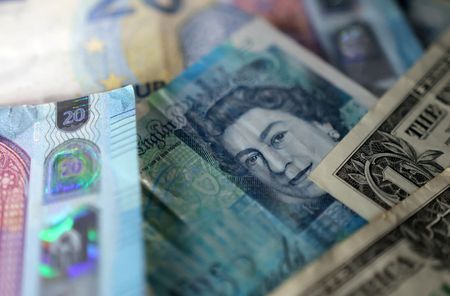(Adds byline)
By Stefano Rebaudo
(Reuters) -Sterling was headed for its third straight weekly loss against the dollar and the euro on Friday as investors digested the Bank of England’s rate decision and looked ahead to the government’s budget later this month.
A narrow vote and signs that BoE Governor Andrew Bailey may soon join those favouring a cut have raised the odds of a December easing move.
The BoE held rates, disappointing the most dovish expectations after a minority of analysts had bet on a 25-basis-point cut.
MORE ROOM TO EASE IN 2026
Markets now expect the British government to unveil a significant fiscal tightening package in its Autumn Statement, creating more room for the BoE to ease further next year.
The greenback was on track for a modest weekly gain as investors weighed the Fed’s hawkish tilt against lingering concerns over the U.S. economy.
Sterling fell 0.27% to $1.3105, set for a 0.50% weekly drop. It fell 1.1% last week and 0.90% the week before. Investors are betting on a December rate cut after Thursday’s tight vote, with this month’s budget likely to add volatility for the pound.
“We expect pound weakness to extend against the euro into year-end if slower inflation is confirmed in October and November,” said Lee Hardman, senior currency analyst at MUFG.
The euro rose 0.25% to 88.10 pence and was on track to end the week up 0.44%, after gains of 0.42% last week and 0.64% the week before.
“There is scope for lower short-term rates and a weaker pound,” said Chris Turner, global head of forex strategy at ING, noting markets were not fully pricing a December cut.
“We expect the euro to find good support near 0.8760 and trade above 0.88 heading into the Budget later this month,” he added.
Traders are pricing a 60% chance of a 25 bps BoE cut and 58 bps of easing by end-2026. British 2-year yields, more sensitive to expectations for policy rates, were up 1.5 bps at 4.11% on Friday, after falling 6.5 bps the day before.
Markets expect the European Central Bank’s key policy rate to remain steady at 2% through early 2027.
(Reporting by Stefano Rebaudo; Editing by Alex Richardson)










